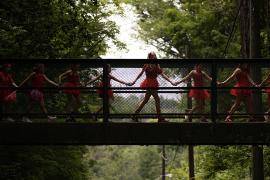For the past several years, ACA has invited day and resident camps to complete an online camper enrollment survey. The survey asks camp directors to respond to questions regarding enrollment trends, return rates, capacity, and scholarship support offered to campers. We gather these data in the spring to get a pulse on what the upcoming summer looks like and then again later in the fall to gauge consistency in the data, to gather additional details, and assess overall trends. Our goal is to offer insight into enrollment trends and give camp professionals important information to inform their busi¬ness operations. For the fall of 2011, however, only 102 directors (out of a randomly selected 675) completed the online camper enrollment survey for a ~15 percent response rate. Because of this low response rate, ACA is unable to provide its normally substantive enrollment article, and we cannot determine detailed enrollment trends or comparisons. However, we have compiled a snapshot of the results from the online enrollment survey — although the information should be interpreted with caution. Results from the full camper enrollment survey can be found on the camper enrollment research Web site: www.ACAcamps.org/research/improve/enrollment-recruitment-survey.
Who Completed the 2011 Summer Camper Enrollment Survey?
Among the respondents, over half (66.3 percent) were resident camps, and 33.7 percent were day camps. The majority of directors identified their camp as independent nonprofit (32.4 percent), followed by: for-profit (31.4 percent), agency (19 percent), religious (15.2 percent), and government/municipal (1.9 percent). Most (80 percent) of the camps were co-ed.
Camper Enrollment Highlights
- The majority of directors (57 percent) reported that compared to 2010, camper enrollment was higher this summer, while 22 percent reported that enrollment was lower than last year, and 21 percent said they stayed the same. For those camps that saw increased enrollments, 30 percent of the directors reported that the increase was greater than 10 percent. An additional 30 percent of directors said the increase in enrollment was between 4 and 7 percent. As in years past, these percentages mirrored what was indicated in the Spring Peek survey, where 80 percent of the directors said their enrollments were the same or higher than the past year.
- When asked to compare camper enrollment over the last five years, 29 percent of directors said their 2011 enrollment was the highest. On the other hand, nearly 20 percent reported that enrollment was lower than most of the past five years.
- Total number of campers enrolled during the 2011 summer indicated that for the majority of camps (32 percent), enrollment for the summer was less than 300 campers. Twenty-five percent of directors reported enrollment between 300–650 campers, 16 percent with 650–999 campers, and over 25 percent of directors reported having 1,000+ campers.
- The majority of directors said that enrollment for both boys and girls, in camper weeks, was the same as last year. Nearly 40 percent of directors reported that enrollment for teens had increased from last year, but the increase was small (1–3 percent).
- Most directors (37 percent) said that the number of camper enrollments for one-week sessions increased from last year and that one-week sessions were their most popular session length offered.
- Forty-three percent of directors said that between 50 and 75 percent of their campers were returning campers. Compared to last year, the majority (63 percent) of directors said that enrollment of returning campers was the same as last year, which confirmed that trend in the 2011 Spring Peek survey.
- Nearly 50 percent of directors said they reached 90–100 percent capacity for the 2011 summer. In addition, 68 percent reported they had achieved 90–100 percent of their targeted capacity. On the other hand, 13 percent reported achieving less than 80 percent of their targeted capacity.
- For camps that intentionally set a targeted enrollment less than the camp’s actual capacity, many (33 percent) reported that their reasons had to do with planning for reduced growth due to the current economy.
- Compared to last year, the number of campers who received financial support was higher (39 percent), which was about 10 percent more than anticipated in the 2011 Spring Peek survey. Over 20 percent of the directors said their financial support for campers was between $25,000 and $50,000.
Opinions about Camper Enrollment
When asked what the top two enrollment issues were for the summer of 2011, five main themes were identified. Directors’ responses that capture the main idea of these themes are in quotes.
- Economic Challenges — “We do not have numbers to support our program financially”; “Still catching up from the economy — would like to get back to pre-2008 status quo.”
- Late Registration — “Parents waiting until the last minute to register”; “One third of enrollment came after June 1!”
- Marketing — “We cannot afford to market effectively”; “Getting the word out.”
- Scholarship Funds — “More scholarship requests than we could provide”; “More camper subsidies than previous years”; and “More parents requesting financial aid.”
- Session Enrollment — “Some parents would have preferred shorter sessions, but we have not offered them”; “Campers enrolling for fewer weeks.”
So What Can We Learn?
While it was disappointing that the low response rate hampered our abilities to confidently provide more details and projections about enrollment, we are able to provide some general messages about camper enrollment from 2011. First, recovery of camper enrollments seems to be happening across the board in day and resident camps. While directors still express concerns about the economy, there appears to be cautious optimism as enrollments increase and capacity targets are reached. Second, while some families are regaining economic stability, we know camp scholarships are still a huge need for many children. With concerns about a disappearing US middle class and a burgeoning poverty class where one out of five children lives in poverty, camps will continue to be faced with implications from these social challenges that focus on economics, race/ethnicity, gender, and education. The last message comes from the actual process associated with gathering information needed to understand and articulate what is happening within our camp communities and our profession as a whole. Without the support of each individual professional willing to share his or her data, we cannot accurately tell our story with the evidence needed to back it up. Sometimes, we humans find it all too easy to believe that our individual response will not be missed, even if the information is something we are personally interested in. However, we are a collective, and our impact is largest when we all contribute to the story. So the next time a request comes to you to participate in a data collection opportunity, we hope you will remember what was overheard recently at a conference: “Oh, yeah, I filled out that enrollment survey. It only took me about five minutes, and what I get back for that investment of time is well worth it!”
As a reminder, we will be inviting camp directors to complete the camper enrollment survey again in spring 2012, and then later in fall 2012. We hope that everyone selected to receive the camper enrollment surveys will take the five to seven minutes needed to complete the survey so that next year we can provide you with the most accurate and informative reports possible.
The Population of Children in the USAdditional information about the overall population of children in the US can be found in the following two resources:
|
Cass Morgan is a research assistant with ACA and is currently working on her doctorate in parks, recreation, and tourism at the University of Utah.
Deborah Bialeschki, Ph.D., is director of research for the American Camp Association. She can be contacted at dbialeschki@ACAcamps.org.
Originally published in the 2012 March/April Camping Magazine.



